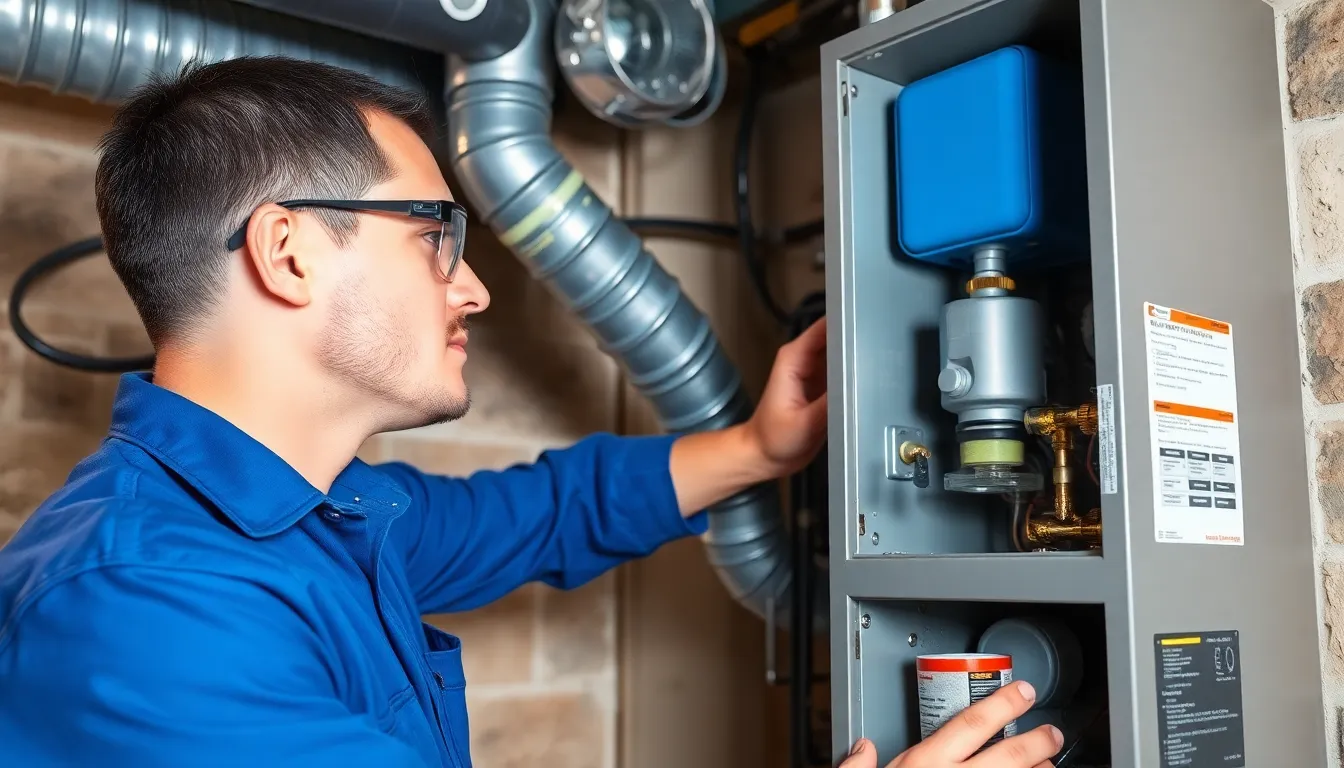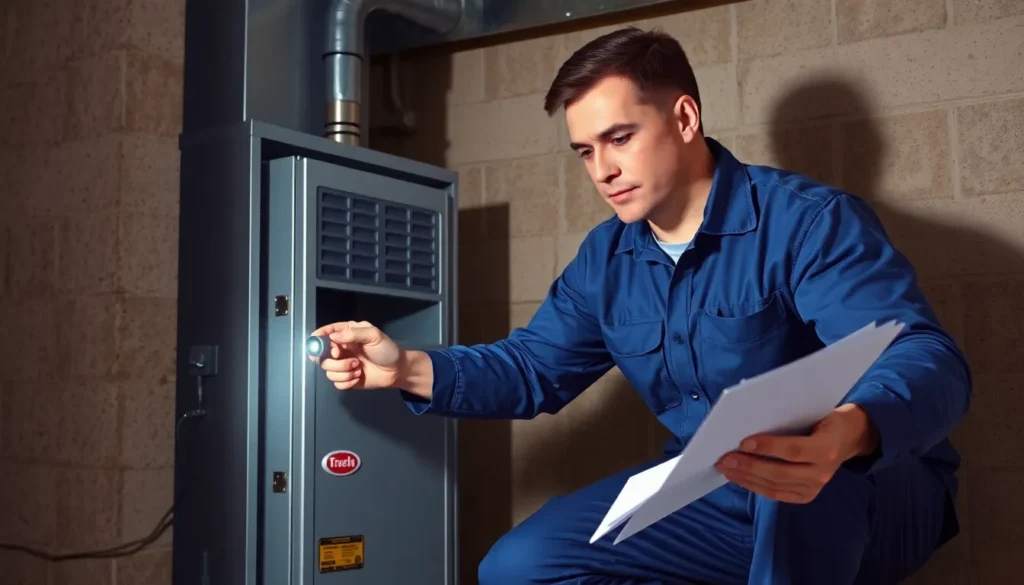As the chilly winds start to howl, the last thing anyone wants is a furnace that’s more temperamental than a cat on a rainy day. Regular furnace inspections aren’t just a good idea; they’re the secret sauce to keeping your home cozy and your heating system in tip-top shape. Imagine snuggling up under a blanket with a hot cocoa, knowing your furnace won’t throw a tantrum mid-winter.
Neglecting that inspection might lead to a surprise visit from your local repair technician—and trust us, nobody wants that kind of uninvited guest. With a simple check-up, you can avoid costly repairs and ensure your furnace runs smoothly all season long. Let’s dive into why scheduling a furnace inspection is the smartest decision you can make this winter.
Importance Of Furnace Inspection
Regular furnace inspections enhance home safety and comfort. A well-maintained furnace prevents hazards like carbon monoxide leaks, protecting occupants’ health.
Enhancing Safety
Safety is a primary concern for homeowners. Inspections identify worn or damaged parts early. Technicians check for gas leaks and ensure exhaust systems function properly. Regular evaluations reduce the risk of fires, ensuring a safer living environment. Homeowners can rest easy knowing their heating system operates without risks.
Improving Efficiency
Efficiency plays a significant role in energy savings. A furnace that receives regular inspections runs more smoothly, leading to lower energy bills. Technicians clean and adjust components to optimize performance. Improved efficiency not only conserves energy but also extends the furnace’s lifespan. Homeowners save money on repairs and replacements when they prioritize inspections.
Common Issues Found During Furnace Inspections

Furnace inspections often reveal common issues that can affect performance and safety. Addressing these problems quickly ensures an efficient heating system.
Dirty Filters
Dirty filters obstruct airflow, leading to inefficiency. The filtration system traps dust and debris, which accumulate over time. Reduced airflow can cause the furnace to work harder, increasing energy bills. Regular inspections often uncover this issue, allowing for timely filter replacements. Homeowners benefit from maintaining clean filters for optimal performance and indoor air quality. Neglecting filter maintenance affects both the furnace’s efficiency and the comfort of the living space.
Gas Leaks
Gas leaks pose serious safety risks during furnace operation. Inspections help identify any leaks in the system, preventing hazardous situations. A properly functioning furnace should have no detectable gas leaks. Detecting a leak typically involves checking connections and gas lines for any damage. Early identification allows for swift repairs, protecting occupants from potential dangers like carbon monoxide exposure. Ensuring integrity in gas lines fortifies overall home safety and peace of mind.
The Furnace Inspection Process
Furnace inspections consist of a systematic approach to ensuring optimal performance and safety. The process involves both visual inspection and functional testing, which together maintain indoor comfort.
Visual Inspection
During visual inspections, technicians examine key components of the furnace. They check for signs of wear, corrosion, and improper mounting. Inspectors also assess the condition of filters, vents, and ductwork. Identifying dirty or damaged filters prevents airflow issues, improving efficiency and lowering energy bills. Evaluating gas connections and electrical wiring further ensures safety against potential hazards. Technicians also look for signs of leaks or moisture accumulation, indicative of larger issues. This proactive examination catches problems early, allowing homeowners to address them before they escalate.
Functional Testing
Functional testing involves running the furnace to assess its operation. Technicians test the thermostat for accuracy by measuring temperature settings and adjustments. They also monitor the igniter and flame characteristics, ensuring proper ignition and combustion processes. Observing airflow from vents evaluates the efficiency of heat distribution throughout the home. Checking the exhaust system for blockages ensures that gases vent properly, safeguarding against dangerous carbon monoxide buildup. This hands-on approach identifies functional discrepancies that require immediate correction, enhancing overall performance and safety of the heating system.
Choosing A Professional For Furnace Inspection
Choosing a qualified professional enhances the effectiveness of furnace inspections. Selecting the right technician involves evaluating their qualifications and expertise.
Qualifications To Look For
Experience in HVAC systems is crucial. Licensure and certification, such as NATE or EPA certifications, ensure adherence to industry standards. Knowledge of local building codes fosters compliance and safety. A good technician understands various furnace types and their specific needs. Consistent positive reviews and testimonials highlight a technician’s reliability and performance. Additionally, insurance coverage protects both the technician and the homeowner in case of accidents.
Questions To Ask
Inquiries about experience with specific furnace models can reveal a technician’s expertise. Asking for references from previous clients provides insight into their work quality. Clarifying the inspection process gives an understanding of what to expect. Confirming the availability of warranty or guarantee on work can enhance peace of mind. It’s also essential to ask about pricing structures and any additional fees. Understanding the technician’s approach to maintenance recommendations ensures alignment with homeowner expectations.
Regular furnace inspections are a vital step for homeowners looking to maintain a safe and efficient heating system. By prioritizing these inspections, they can prevent costly repairs and enhance overall comfort during the colder months.
Addressing potential issues early not only ensures optimal performance but also safeguards against serious hazards like carbon monoxide leaks. Choosing a qualified technician for these inspections further guarantees that the furnace operates smoothly and efficiently.
Investing time and resources into furnace inspections pays off in the long run, leading to lower energy costs and a longer lifespan for the heating system. A proactive approach to furnace care allows homeowners to enjoy a worry-free winter season.





